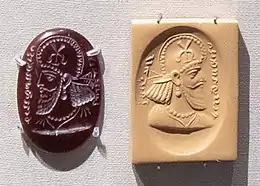Kulāf
A kulāf, or kolāh, is a type of cap that designated Sasanian nobility and official.[3] It appears on numerous reliefs and seals of the Sasanian Empire period.[3]
_composite.jpg.webp)
Stamp seal with a bearded figure in Sasanian dress, wearing the kulāf denoting nobility and officials; and a figure with radiate crown, both with royal ribbons. Attributed to the Hephthalites,[1] and recently dated to the 5th-6th century CE.[2] Stamp seal (BM 119999), British Museum.
The kulāf is often decorated with pearls, on the edge and on the surface of the cap.[3] It may also be shown with an emblem or tamgha on the surface.[3]
%252C_excavated_in_Northern_Syria%252C_5th_century_CE_British_Museum_135071.jpg.webp) Sasanian seal of an official wearing the kulāf, with Pahlavi inscription "Roz-bud, chief wine-purchaser" (disputed), excavated in Northern Syria, 5th century CE, British Museum 135071
Sasanian seal of an official wearing the kulāf, with Pahlavi inscription "Roz-bud, chief wine-purchaser" (disputed), excavated in Northern Syria, 5th century CE, British Museum 135071 Sasanian seal with portrait of an official wearing the kulāf, inscription in Pahlavi "Perozhormizd, son of the Kanarang", 5th century CE British Museum 134847.
Sasanian seal with portrait of an official wearing the kulāf, inscription in Pahlavi "Perozhormizd, son of the Kanarang", 5th century CE British Museum 134847.
References
- KURBANOV, AYDOGDY (2010). THE HEPHTHALITES: ARCHAEOLOGICAL AND HISTORICAL ANALYSIS (PDF). Berlin: Berlin Freie Universität. p. 69, item 1).
- Latest 5th-6th century CE date in Livshits (2000) LIVSHITS, V. A. (2000). "Sogdian Sānak, a Manichaean Bishop of the 5th–Early 6th Centuries" (PDF). Bulletin of the Asia Institute. 14: 48. ISSN 0890-4464.. According to earlier sources (Bivar (1969) and Livshits (1969), repeated by the British Museum) the seal was dated to the 300-350 CE in Naymark, Aleksandr. "SOGDIANA, ITS CHRISTIANS AND BYZANTIUM: A STUDY OF ARTISTIC AND CULTURAL CONNECTIONS IN LATE ANTIQUITY AND EARLY MIDDLE AGES" (PDF): 167. Cite journal requires
|journal=(help), "Stamp-seal; bezel British Museum". The British Museum. - Lerner, Judith A.; Sims-Williams, Nicholas (2011). Seals, sealings and tokens from Bactria to Gandhara : 4th to 8th century CE. Wien: Verlag der Österreichischen Akademie der Wissenschaften. pp. 35, 100–101. ISBN 978-3700168973.
This article is issued from Wikipedia. The text is licensed under Creative Commons - Attribution - Sharealike. Additional terms may apply for the media files.